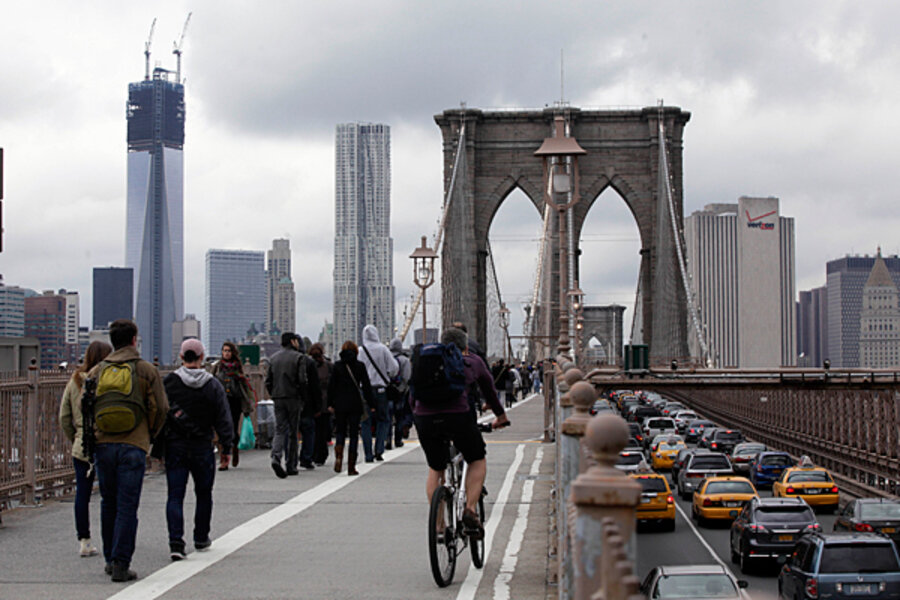View from a transit bus as a Sandy-immobilized New York gets going
Loading...
| New York
New York began Wednesday to crawl toward normalcy after being immobilized for two days by hurricane Sandy. The stock market opened on time. Two of the area's three airports – JFK International and Newark (N.J.) International – resumed flights, although on very limited schedules. Bridges connecting Manhattan with Queens and Brooklyn reopened. And, after days of reporting from a makeshift home office, your Monitor reporter decided to make the 2-1/2-mile trek to the newspaper's Midtown office.
This is usually a relatively fast and hassle-free affair: two subway rides and, 20 minutes later, I’m there.
But on Wednesday, the first day that "the city that never sleeps" has stirred since Sandy came ashore on Monday, forgetaboutit.
The subways are still closed, as the Metropolitan Transit Authority (MTA) continues to pump water out of flooded underground stations. Instead, the MTA is running free buses. Yes, there is a route only a few blocks from my apartment on the Upper West Side.
Ordinarily, bus service is slow but reliable. The fleet of 5,600 buses usually carries 2.5 million riders a day, says the MTA.
Could I be one of those Wednesday morning? Only if I can manage to squeeze onto a bus already crammed with other West Side residents. But, hey, the back door of the bus is open, and look, a few unoccupied square inches!
This ride from the West Side to Midtown usually takes about 30 minutes. On an express bus, it can be less than 20. But we are barely inching down Broadway. Why so slow?
Ah-hah, the West Side Highway, which moves cars to lower Manhattan, remains closed. And because the subway service is suspended, many New Yorkers have apparently decided to drive – via Broadway – to get downtown.
Not only are drivers being funneled to local streets, but once there, they discover that Seventh Avenue, another major downtown throughway, is closed because of the damaged crane still dangling from the top of a skyscraper under construction. The company building this condo high-rise – mainly for billionaires – has to figure out how to get the crane down safely.
New Yorkers driving their cars to work are a relatively rare sight. The city has the lowest per capita ownership of vehicles in the nation. Over half of New Yorkers don’t even own cars, according to the US Department of Transportation in a 2001 study.
But judging from the traffic, all those who do have vehicles are on the streets Wednesday morning. And then there is the debris. A tree had come down, and its limbs closed off one lane of southbound Broadway. Traffic, and my bus, detour around it and other detritus.
The upshot? In 15 minutes, my bus has traveled a grand total of five blocks. It's probably faster to walk. New Yorkers are generally good at this. In transit strikes in 1980 and again in 2005, millions of New Yorkers put on their running shoes, dusted off their bicycles, or shared taxi cabs.
So, no surprise, the sidewalks on Broadway are crowded, too. Scores of fellow New Yorkers have evidently decided the two-legged option will be quicker. Normally, many would go through Central Park. But the city has shut down the parks because of the danger of falling tree limbs.
As I near Fifth Avenue, my fellow walkers all seem to be talking in a language other than English. I probably should not be surprised. According to New York City & Co., which promotes tourism in the Big Apple, some 48.8 million foreigners visited the city in 2011. On this particular day, a good portion of them seem to be looking at maps and trying to figure out how to see parts of the city reachable by foot.
Normally, some of these well-heeled travelers might stop at Tiffany & Co. or some of the other luxury jewelry dealers. But those showcases on Fifth Avenue are bare: The jewelry companies have removed diamonds and other gems. Perhaps they were afraid of damage to their windows? Or maybe something worse – looting.
Wednesday morning, however, the streets are swarming with police officers. The city has the largest force in the nation: 34,500 strong. Still, that's the slimmest the NYPD has been since 1992, although Mayor Michael Bloomberg likes to note that crime has been falling in the city and that New York does not need more police because it is making better use of technology.
By this time, I'm at Rockefeller Center, and a city bus has arrived. There is a little space to squeeze on, so I ride the last 10 blocks to the office. Time on the road, so to speak: about an hour.
Of course, for many commuters that’s not bad. And on Wednesday, many people are still working from home. All of the rail lines into New York from New Jersey and Long Island remain closed. And Metro-North, which runs trains from the Hudson Valley and Connecticut, has not yet determined when its service will resume, according to its website. It pointed out that it has yet to cope with a 40-foot power boat that had washed up on the tracks at Ossining, N.Y.
At least I didn’t start the day with a problem that size.







